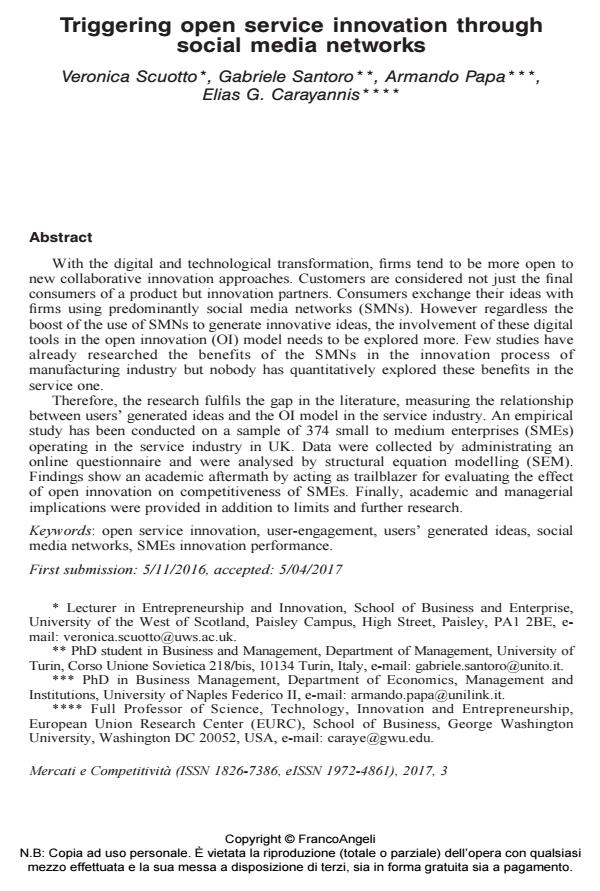Triggering open service innovation through social media networks
Titolo Rivista MERCATI & COMPETITIVITÀ
Autori/Curatori Veronica Scuotto, Gabriele Santoro, Armando Papa, Elias G. Carayannis
Anno di pubblicazione 2017 Fascicolo 2017/3
Lingua Inglese Numero pagine 20 P. 21-40 Dimensione file 133 KB
DOI 10.3280/MC2017-003003
Il DOI è il codice a barre della proprietà intellettuale: per saperne di più
clicca qui
Qui sotto puoi vedere in anteprima la prima pagina di questo articolo.
Se questo articolo ti interessa, lo puoi acquistare (e scaricare in formato pdf) seguendo le facili indicazioni per acquistare il download credit. Acquista Download Credits per scaricare questo Articolo in formato PDF

FrancoAngeli è membro della Publishers International Linking Association, Inc (PILA)associazione indipendente e non profit per facilitare (attraverso i servizi tecnologici implementati da CrossRef.org) l’accesso degli studiosi ai contenuti digitali nelle pubblicazioni professionali e scientifiche
With the digital and technological transformation, firms tend to be more open to new collaborative innovation approaches. Customers are considered not just the final consumers of a product but innovation partners. Consumers exchange their ideas with firms using predominantly social media networks (SMNs). However regardless the boost of the use of SMNs to generate innovative ideas, the involvement of these digital tools in the open innovation (OI) model needs to be explored more. Few studies have already researched the benefits of the SMNs in the innovation process of manufacturing industry but nobody has quantitatively explored these benefits in the service one. Therefore, the research fulfils the gap in the literature, measuring the relationship between users’ generated ideas and the OI model in the service industry. An empirical study has been conducted on a sample of 374 small to medium enterprises (SMEs) operating in the service industry in UK. Data were collected by administrating an online questionnaire and were analysed by structural equation modelling (SEM). Findings show an academic aftermath by acting as trailblazer for evaluating the effect of open innovation on competitiveness of SMEs. Finally, academic and managerial implications were provided in addition to limits and further research.
Parole chiave:Open service innovation, user-engagement, users’ generated ideas, social media networks, SMEs innovation performance.
- The sourcing for collaborative knowledge translation in distributed R&D processes: a cross-regional study Luana Serino, Armando Papa, Francesco Campanella, Leonardo Di Gioia, in Management Decision /2020 pp.2027
DOI: 10.1108/MD-11-2019-1621 - Leveraging Social Media for SMEs: Findings from a Bibliometric Review Alfonso Pellegrino, Masato Abe, in Sustainability /2023 pp.7007
DOI: 10.3390/su15087007 - Big data for business management in the retail industry Gabriele Santoro, Fabio Fiano, Bernardo Bertoldi, Francesco Ciampi, in Management Decision /2019 pp.1980
DOI: 10.1108/MD-07-2018-0829 - Niche tourism destinations’ online reputation management and competitiveness in big data era: evidence from three Italian cases Valentina Cillo, Riccardo Rialti, Manlio Del Giudice, Antonio Usai, in Current Issues in Tourism /2021 pp.177
DOI: 10.1080/13683500.2019.1608918 - Cybernetics, Cognition and Machine Learning Applications Madhavi Latha Challa, K. L. S. Soujanya, C. D. Amulya, pp.235 (ISBN:978-981-15-1631-3)
- Converting Shelf-Based Scarcity into Innovation by Adopting Customer-Focused Innovation Approach Antonio Usai, Daniele Porcheddu, Veronica Scuotto, Jean-Paul Susini, in Journal of the Knowledge Economy /2020 pp.70
DOI: 10.1007/s13132-018-0536-y
Veronica Scuotto, Gabriele Santoro, Armando Papa, Elias G. Carayannis, Triggering open service innovation through social media networks in "MERCATI & COMPETITIVITÀ" 3/2017, pp 21-40, DOI: 10.3280/MC2017-003003